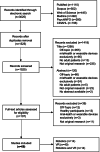A systematic review on the usability of robotic and virtual reality devices in neuromotor rehabilitation: patients' and healthcare professionals' perspective
- PMID: 35443710
- PMCID: PMC9020115
- DOI: 10.1186/s12913-022-07821-w
A systematic review on the usability of robotic and virtual reality devices in neuromotor rehabilitation: patients' and healthcare professionals' perspective
Abstract
Background: The application of virtual reality (VR) and robotic devices in neuromotor rehabilitation has provided promising evidence in terms of efficacy, so far. Usability evaluations of these technologies have been conducted extensively, but no overviews on this topic have been reported yet.
Methods: A systematic review of the studies on patients' and healthcare professionals' perspective through searching of PubMed, Medline, Scopus, Web of Science, CINAHL, and PsychINFO (2000 to 2021) was conducted. Descriptive data regarding the study design, participants, technological devices, interventions, and quantitative and qualitative usability evaluations were extracted and meta-synthetized.
Results: Sixty-eight studies were included. VR devices were perceived as having good usability and as a tool promoting patients' engagement and motivation during the treatment, as well as providing strong potential for customized rehabilitation sessions. By contrast, they suffered from the effect of learnability and were judged as potentially requiring more mental effort. Robotics implementation received positive feedback along with high satisfaction and perceived safety throughout the treatment. Robot-assisted rehabilitation was considered useful as it supported increased treatment intensity and contributed to improved patients' physical independence and psychosocial well-being. Technical and design-related issues may limit the applicability making the treatment difficult and physically straining. Moreover, cognitive and communication deficits were remarked as potential barriers.
Conclusions: Overall, VR and robotic devices have been perceived usable so far, reflecting good acceptance in neuromotor rehabilitation programs. The limitations raised by the participants should be considered to further improve devices applicability and maximise technological rehabilitation effectiveness.
Trial registration: PROSPERO registration ref. CRD42021224141 .
Keywords: Rehabilitation; Robotics; Systematic Review; Usability; Virtual Reality.
© 2022. The Author(s).
Conflict of interest statement
The authors declare that they have no competing interests.
Figures



References
-
- Iandolo R, Marini F, Semprini M, Laffranchi M, Mugnosso M, Cherif A, et al. Perspectives and Challenges in Robotic Neurorehabilitation. Appl Sci. 2019;9:3183. doi: 10.3390/app9153183. - DOI
Publication types
MeSH terms
LinkOut - more resources
Full Text Sources

